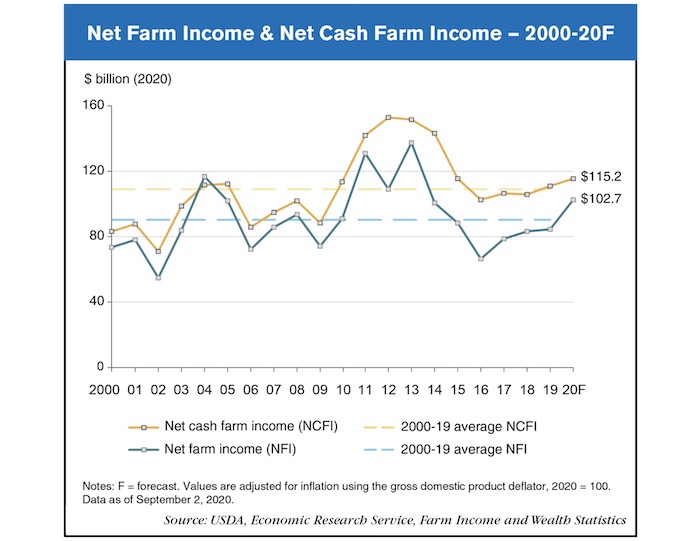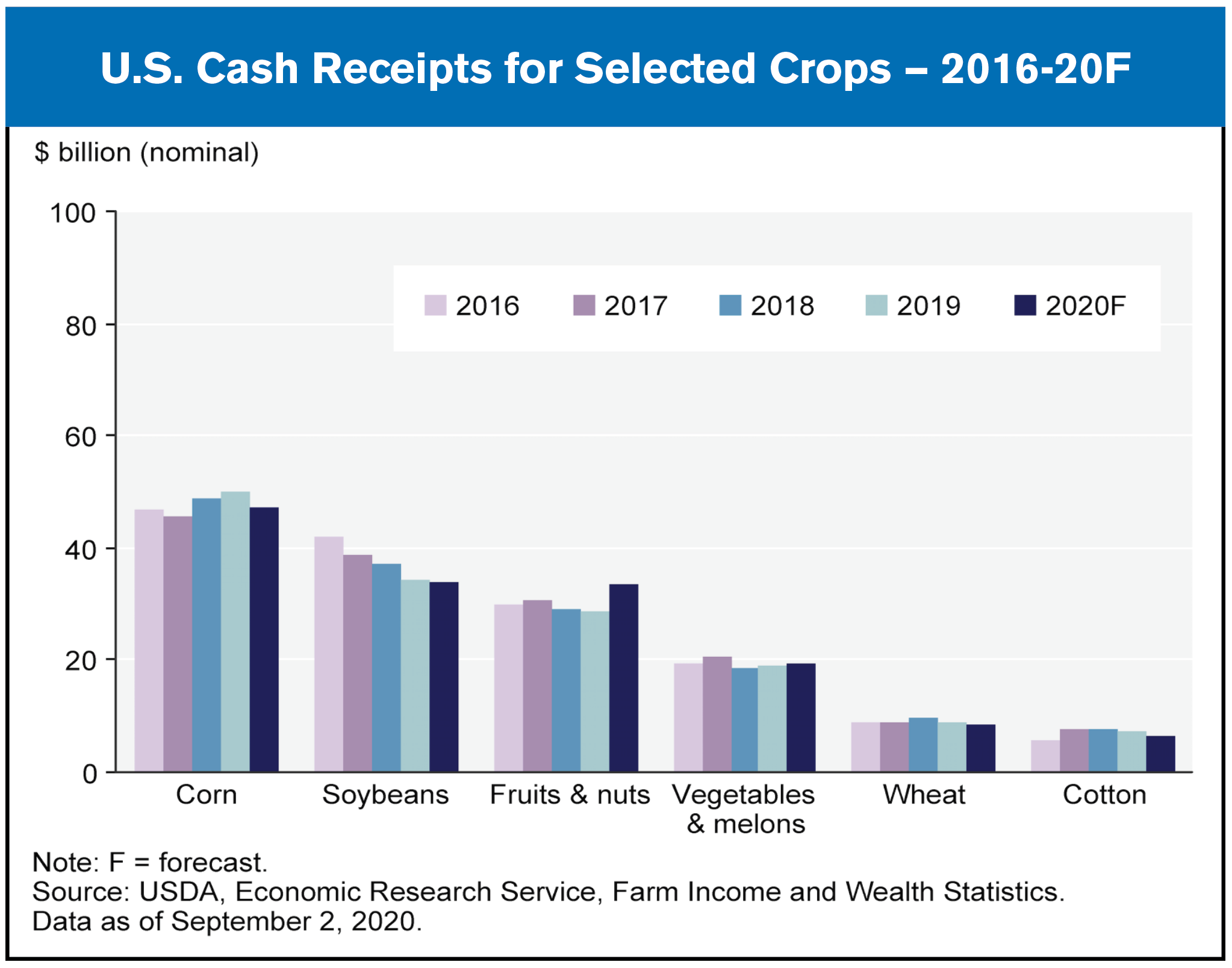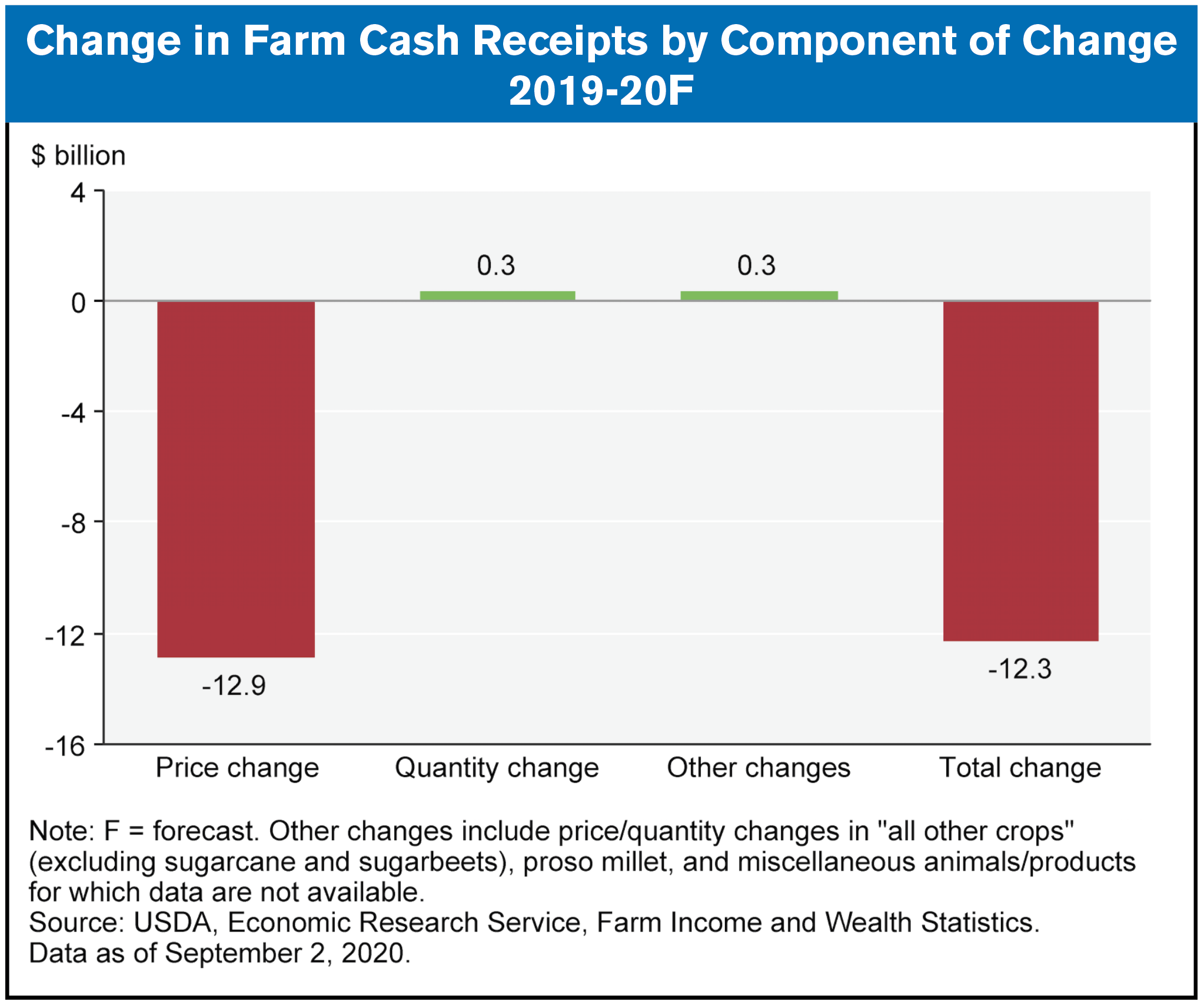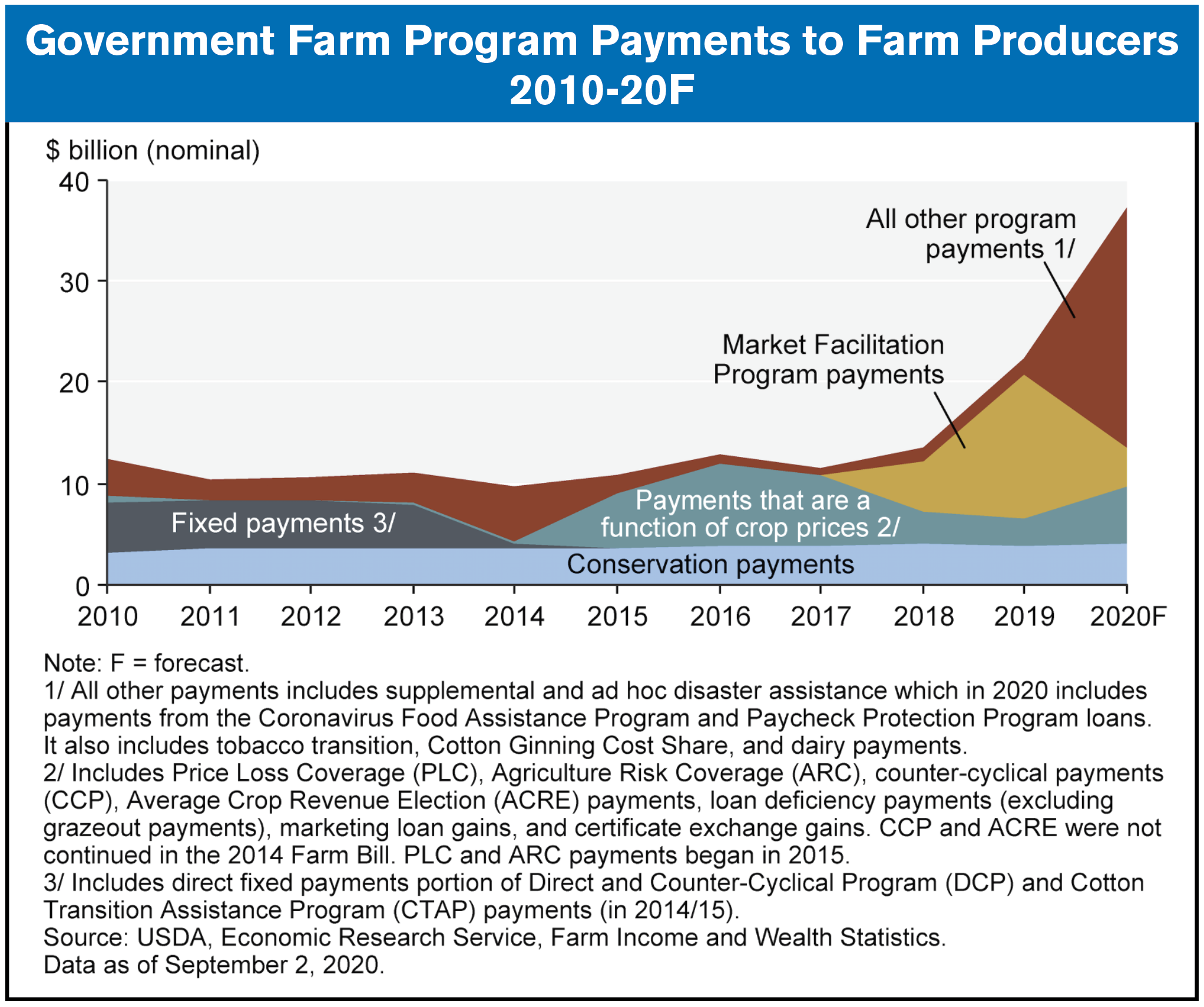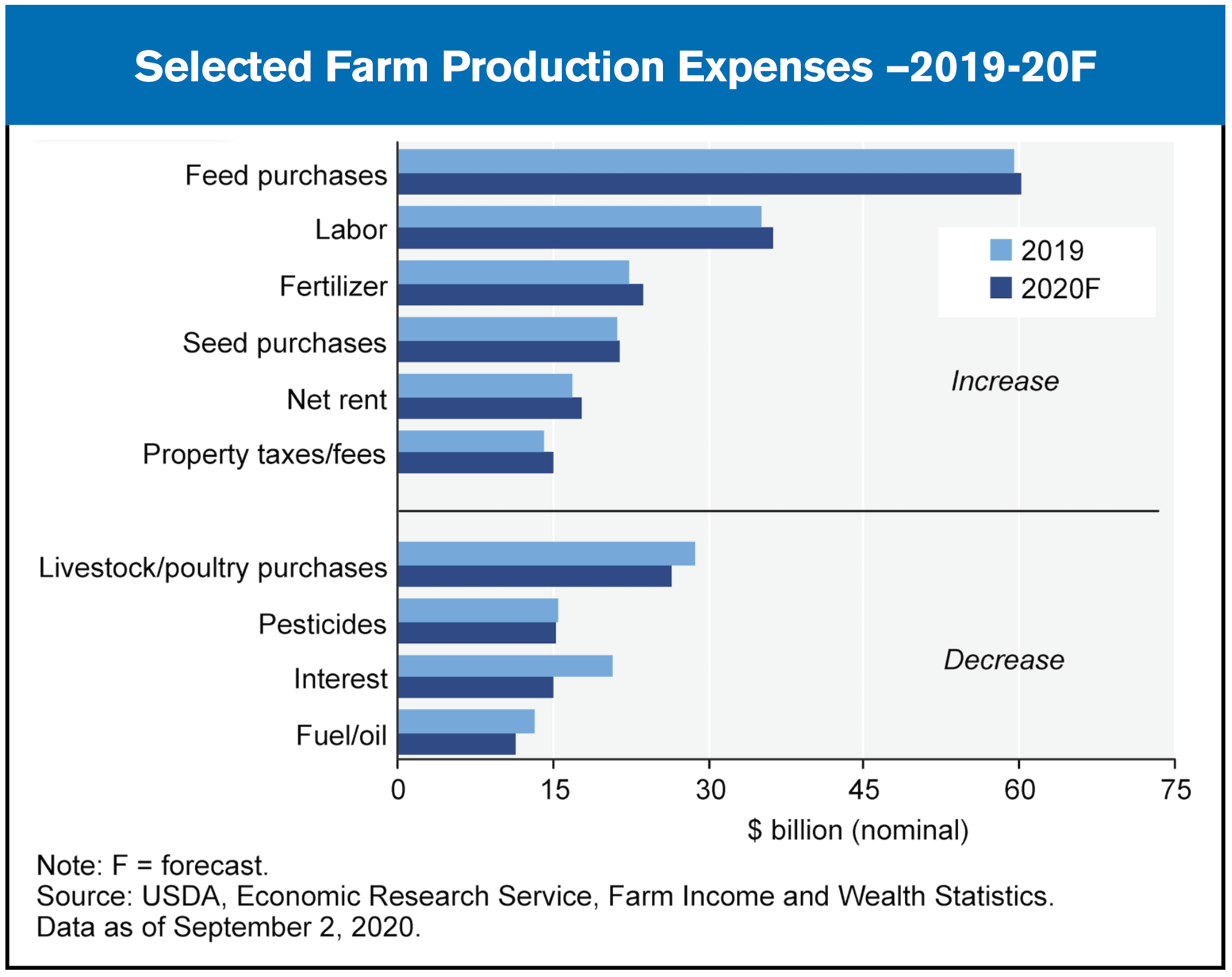On Sept. 2, USDA’s Economic Research Service (ERS) released its updated Farm Sector Income and Finances report and projected that farm profits would improve in 2020 relative to 2019.
According to the ag agency, the improving bottom line for farmers will result from slightly higher crop receipts, lower production expenses and a hefty increase in government assistance.
The major findings of the updated ERS report include:
- Overall, farm cash receipts are forecast to decrease $12.3 billion (3.3%) to $358.3 billion in 2020. Total animal/animal product receipts are expected to decrease $14.3 billion (8.1%) following declines in receipts for broilers, cattle/calves, hogs and milk. Total crop receipts are forecast to increase $2 billion (1%) from 2019 levels. Receipts for fruits and nuts are expected to increase while receipts for corn, wheat, cotton and soybeans are expected to decline.
- Direct government farm payments — which include Federal farm program payments paid directly to farmers and ranchers but exclude USDA loans and insurance indemnity payments made by the Federal Crop Insurance Corp. — are forecast at $37.2 billion, a $14.7 billion increase (65.7%). The expected increase is due to supplemental and ad hoc disaster assistance for COVID-19 relief.
- Total production expenses, including expenses associated with operator dwellings, are forecast to decrease $4.6 billion (1.3%) in 2020 to $344.2 billion. Interest expenses are forecast to decrease $5.6 billion (27.1%) and livestock/poultry purchases to decrease $2.1 billion (7.5%). However, fertilizer expenses are forecast to increase $1.3 billion (5.7%) and cash labor expenses to increase $1.1 billion (3.1%) in 2020.
- Farm sector equity is expected to increase by 0.7% to $2.68 trillion in nominal terms. Farm sector assets are forecast to increase 1.1% in 2020 to $3.11 trillion as farm real estate assets are forecast to increase 1.1%. Farm sector debt is forecast to rise 3.6% to $433.8 billion, with real estate debt forecast to rise 5.5% to $281.6 billion. When adjusted for inflation, farm sector equity is forecast to be relatively unchanged in 2020. Debt-to-asset levels for the sector are trending higher since 2012 and are forecast to rise again in 2020 to 13.95%. Working capital is forecast to decline 12.8% in 2020, after increasing 11.9% in 2019.
(In an explanatory note, the ERS points out that in the summary report, year-to-year changes in the major aggregate components of farm income are discussed only in nominal dollars unless the direction of the change is reversed when looking at the component in inflation-adjusted dollars.)
2020 Crop Receipts Expected to Increase Slightly
Crop cash receipts are forecast at $196.6 billion in 2020, increasing $2 billion (1.0%) from 2019 in nominal terms. Sectors expected to see growth in cash receipts in 2020 include fruits and nuts, and potatoes, while receipts are expected to fall for soybeans, corn, wheat, and cotton.
Soybean receipts in 2020 are expected to decrease $0.2 billion (0.7%) in nominal terms, as lower quantities should outweigh the impact of forecast positive prices relative to 2019. Corn receipts are expected to fall by $3.1 billion (6.2%) in 2020 relative to 2019. The corn forecast is mostly driven by expected lower prices in 2020, but slightly lower quantities sold are also expected. Cotton’s decrease ($0.5 billion or 7.3%) in 2020 receipts reflects expected decreases in receipts for cotton lint compared to cottonseed, which increased slightly. Wheat receipts are forecast to fall $0.6 billion (6.5%) because of forecasted decreases in both price and quantity sold. Hay receipts are forecast to increase $0.4 billion (5.3%) in 2020, resulting from expected higher prices and quantities sold.
Vegetable and melon cash receipts are expected to increase $0.4 billion (2.3%) in nominal terms in 2020. Cash receipts for fruits and nuts are expected to rise $4.9 billion (17%) in 2020, driven by higher forecasted prices.
2020 Animal/Animal Product Receipts Forecast to Decline
Total animal/animal product cash receipts are expected to fall $14.3 billion (8.1%) to $161.7 billion in 2020 in nominal terms. Broilers and hogs are expected to see the largest declines in cash receipts in%age terms, but growth in cash receipts is expected for turkeys and chicken eggs.
Cash receipts from cattle and calves are expected to fall $5.1 billion (7.7%) in nominal terms in 2020. Milk receipts are expected to decrease $0.9 billion (2.2%) during the year, and hog cash receipts are forecast $3.5 billion (15.9%) lower in 2020. Receipts for each of the preceding animal commodities are expected to fall during the year primarily because of lower price forecasts.
Broiler receipts are expected to fall $6.6 billion (23.4%) in 2020, because of significantly lower expectations for prices. Cash receipts for chicken eggs are expected to grow $1 billion (12.4%) in 2020, as higher prices should outweigh lower quantities sold. Higher prices for turkeys drive receipt forecasts higher by $0.8 billion (18%) in 2020, even considering expectations for lower quantities of turkeys sold.
Falling Prices Drive Drop in Cash Receipts in 2020
ERS says that it formulates commodity cash receipt estimates and forecasts from the bottom up, with individual commodity prices and quantities sold contributing to an overall sector measure. To better understand the factors underlying the forecast change in annual receipts from 2019 to 2020, ERS decomposes the change into two separate effects: a “price effect” where it project the change in cash receipts associated with holding the quantity sold at 2019 estimate levels and allowing prices to change to 2020 forecast levels; and a “quantity effect” where prices are assumed at 2019 estimate levels and allowing quantities sold to change to 2020 forecast levels.
Under these assumptions, falling prices are forecast to have a large negative effect on cash receipts in 2020, moderated only slightly by the positive effect coming from higher quantities. This is mainly because of lower price forecasts for animals/animal products. Cash receipts are forecast to decrease $12.3 billion in 2020, with an estimated quantity effect of $0.3 billion, but a projected (negative) price effect of $12.9 billion.
Additionally, an upward shift of $0.3 billion is from forecasts for commodities whose price and quantity effects cannot be separately determined. Price and quantity signals in the forecast are significantly different for crop versus livestock commodities. Positive price effects and negative quantity effects are forecast for crop cash receipts, while the animals/animal products forecast is the opposite, experiencing large negative price effects and a much smaller but positive quantity effect in 2020.
Direct Government Farm Payments Forecast to Increase in 2020
Direct government farm program payments are made directly by the Federal Government to farmers and ranchers with no intermediaries. Most direct payments to farmers and ranchers are administered by USDA under the 2018 Farm Bill.
Government payment amounts do not include Federal Crop Insurance Corp. insurance indemnity payments (listed as a separate component of farm income) or USDA loans (listed as a liability in the farm sector’s balance sheet). Direct government farm program payments are forecast to increase 65.7% ($14.7 billion) from 2019 to 2020. This overall increase reflects higher anticipated payments from supplemental and ad hoc disaster assistance, mainly direct payments for COVID-19 related assistance.
- Overall, supplemental and ad hoc disaster assistance payments in 2020 are forecast at $23.4 billion, an increase of $22 billion from 2019, mainly from payments from the Coronavirus Food Assistance Program (CFAP) and the Paycheck Protection Program (PPP).
- The Coronavirus Food Assistance Program (CFAP) provides direct relief to producers who faced price declines and additional marketing costs due to COVID-19. Payments in calendar year 2020 for this USDA program are forecast at $16 billion.
- Also included under supplemental and ad hoc disaster assistance are payments from the Paycheck Protection Program (PPP), administered by the Small Business Admin. The payments are designed to help small businesses keep their workers on the payroll during the COVID-19 pandemic. Although administered as a “loan,” the loans will be forgiven if the program's requirements are met. ERS treats these loans as a direct payment to farmers and forecast them at $5.8 billion in 2020. This amount may be revised, with any unforgiven amounts ending up as farm debt rather than a direct payment.
- Market Facilitation Program payments, that aid farmers in response to trade disruptions, are expected to continue in 2020, but decline $10.4 billion from 2019 levels. The 2020 forecast at $3.8 billion reflects payments authorized in 2019 but paid in 2020.
- Payments in calendar year 2020 under the Agriculture Risk Coverage (ARC) program are expected to decline $0.6 billion from 2019 levels while Price Loss Coverage (PLC) payments in 2020 are expected to increase $2.8 billion from 2019 levels. Some of the change in payments is because of program participation changes allowed in the 2018 Farm Bill, as producers were permitted to change their program election (ARC or PLC) from what they chose under the 2014 Farm Bill.
- Conservation payments from financial assistance programs of USDA's Farm Service Agency and Natural Resources Conservation Service are expected to rise to $4 billion in 2020, up 5% from 2019.
- The Dairy Margin Coverage Program, that replaced the Dairy Margin Protection Program in the 2018 Farm Bill, is forecast to make net payments of $0.2 billion to dairy operators in 2020.
2020 Production Expenses Forecast to Decrease
Farm sector production expenses (including expenses associated with operator dwellings) are forecast to decrease by $4.6 billion (1.3%) in 2020 in nominal terms. Forecast at $344.2 billion, 2020 production expenses are 19% below the record high of $427.1 billion in 2014 in inflation-adjusted terms and continue a 6 year string of declining expenses. Even though overall production expenses are forecast to decrease, the levels of changes in individual expenses range from 7.1% increase in property taxes to 27.1% decline in interest expenses.
Expense items that are forecast to increase in 2020 account for approximately 69% of total expenses and are forecast to collectively rise by $6 billion relative to 2019. Notably, expenses forecast to increase include feed and cash labor, the largest expense line items.
- Feed purchases, the largest single expense category, are forecast to increase 1.4% (to $60.3 billion) in 2020.
- The second largest expense line item, cash labor, is also forecast to increase in 2020 by 3.1% (to $35.8 billion). Wage rate increases are expected to put upward pressure on hired and contract labor costs.
- Net rent and property taxes combined are forecast to increase by 6% (to $32.9 billion).
Expenses forecast to decline account for 31% of total expenses and are forecast to collectively decline by $10.6 billion. Interest expenses are forecast to be at their lowest level since 2014, declining by $5.6 billion from 2019 (27.1%) resulting from historically low interest rates.
- Livestock and poultry purchases are forecast to decrease by 7.5% to $26.5 billion while pesticides are forecast to decrease 2.1% to $15.2 billion.
- Spending on oils and fuel is expected to decrease by 13.9% to $11.4 billion. This is driven in part by the U.S. Energy Information Agency's August forecast of lower diesel prices (down by 52 cents per gallon) in 2020.

